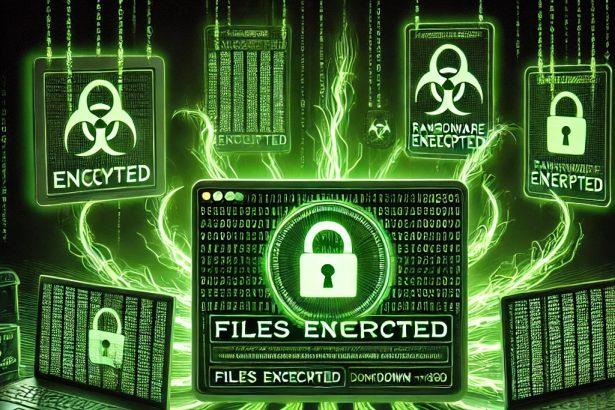JustIce (also styled as Just Ice) is a dangerous ransomware variant that encrypts user files and demands payment for their recovery. First spotted in July 2025, this file-locking malware appends the .JustIce extension to encrypted files and drops a ransom note named README.txt. Victims are instructed to contact the attackers via a provided email address and pay in cryptocurrency to regain access to their data.
What Type of Threat Is JustIce?
| Category | Details |
|---|---|
| Threat type | Ransomware, Crypto-virus, File-locker |
| Encrypted file extension | .JustIce |
| Ransom note file name(s) | README.txt |
| Associated email address | dr.sinaway@gmail.com |
| Detection names | Avast: Win64:Evo-gen [Trj]; Combo Cleaner: Trojan.GenericKD.*; ESET-NOD32: WinGo/Filecoder.Prince.A variant; Kaspersky: HEUR:Trojan-Ransom.Win64.Generic; Microsoft: Ransom:Win64/PrinceRansom!rfn |
| Symptoms of infection | Files become unreadable and renamed with .JustIce; desktop wallpaper changes; ransom note appears on desktop |
| Damage and distribution | Encrypts documents, images, archives, and more; spreads via malicious email attachments, pirated software, tech-support scams, torrent sites, malvertising, and USB drives |
| Danger level | Severe — results in major data loss and high risk of additional malware infection |
| Removal tool | SpyHunter (download here: https://www.enigmasoftware.com/products/spyhunter/?ref=ywuxmtf) |
Ransom Note Contents
---------- JustIce Ransomware ----------
Your files have been encrypted using JustIce Ransomware!
They can only be decrypted by paying us a ransom in cryptocurrency.
Encrypted files have the .JustIce extension.
IMPORTANT: Do not modify or rename encrypted files, as they may become unrecoverable.
Contact us at the following email address to discuss payment.
dr.sinaway@gmail.com
---------- JustIce Ransomware ----------Threat Evaluation & Analysis
How did I get infected?
Infections typically occur when a user unknowingly opens a malicious email attachment, downloads pirated software, falls for fake tech-support alerts, visits compromised torrent platforms, clicks on malicious ads, or connects an infected USB drive. These attack vectors enable the ransomware to silently infiltrate systems and begin its encryption routine.
What does it do?
JustIce ransomware silently encrypts files across the system, modifying filenames with the .JustIce extension. It leaves a ransom note demanding payment and alters the desktop wallpaper to reinforce the threat. The malware disables file access and may also be part of a broader attack, potentially installing secondary payloads or spyware.
Should you be worried for your system?
Yes. JustIce can cause irreversible damage by locking access to important files and pressuring victims into paying large sums of cryptocurrency. There’s no guarantee the attackers will deliver the decryption key, and payment only encourages more attacks. The presence of JustIce also increases the likelihood of further system compromise through backdoors or data harvesting.
Manual Ransomware Removal Guide
Warning: Manual removal is complex and risky. If not done correctly, it can lead to data loss or incomplete removal of ransomware. Only follow this method if you are an advanced user. If unsure, proceed with Method 2 (SpyHunter Removal Guide).
Step 1: Disconnect from the Internet
- Unplug your Ethernet cable or disconnect Wi-Fi immediately to prevent further communication with the ransomware’s command and control (C2) servers.
Step 2: Boot into Safe Mode
For Windows Users:
- For Windows 10, 11:
- Press Windows + R, type
msconfig, and hit Enter. - Go to the Boot tab.
- Check Safe boot and select Network.
- Click Apply and OK, then restart your PC.
- Press Windows + R, type
- For Windows 7, 8:
- Restart your PC and press F8 repeatedly before Windows loads.
- Select Safe Mode with Networking and press Enter.
For Mac Users:
- Restart your Mac and immediately press and hold the Shift key.
- Release the key once you see the Apple logo.
- Your Mac will start in Safe Mode.
Step 3: Locate and Terminate Malicious Processes
For Windows Users:
- Press Ctrl + Shift + Esc to open Task Manager.
- Look for suspicious processes (e.g., unknown names, high CPU usage, or random letters).
- Right-click on the process and select End Task.
For Mac Users:
- Open Activity Monitor (Finder > Applications > Utilities > Activity Monitor).
- Look for unusual processes.
- Select the process and click Force Quit.
Step 4: Delete Malicious Files
For Windows Users:
- Press Windows + R, type
%temp%, and hit Enter. - Delete all files in the Temp folder.
- Navigate to:
C:\Users\[Your Username]\AppData\RoamingC:\Users\[Your Username]\AppData\LocalC:\Windows\System32
- Look for suspicious files related to the ransomware (random file names, recently modified) and delete them.
For Mac Users:
- Open Finder and go to Go > Go to Folder.
- Type
~/Library/Application Supportand delete suspicious folders. - Navigate to
~/Library/LaunchAgentsand remove unknown.plistfiles.
Step 5: Remove Ransomware from Registry or System Settings
For Windows Users:
Warning: Incorrect changes in the Registry Editor can damage your system. Proceed with caution.
- Press Windows + R, type
regedit, and hit Enter. - Navigate to:
HKEY_CURRENT_USER\SoftwareHKEY_LOCAL_MACHINE\Software
- Look for unfamiliar folders with random characters or ransomware-related names.
- Right-click and select Delete.
For Mac Users:
- Go to System Preferences > Users & Groups.
- Click on Login Items and remove any suspicious startup items.
- Navigate to
~/Library/Preferencesand remove malicious.plistfiles.
Step 6: Restore System Using System Restore (Windows) or Time Machine (Mac)
For Windows Users:
- Press Windows + R, type
rstrui, and hit Enter. - Click Next, choose a restore point before the infection, and follow the prompts to restore your system.
For Mac Users:
- Restart your Mac and hold Command + R to enter macOS Utilities.
- Select Restore from Time Machine Backup.
- Choose a backup prior to the ransomware infection and restore your system.
Step 7: Use a Decryption Tool (If Available)
- Visit No More Ransom (www.nomoreransom.org) and check if a decryption tool is available for your ransomware variant.
Step 8: Recover Files Using Backup
- If you have backups on an external drive or cloud storage, restore your files.
Automatic Ransomware Removal Using SpyHunter
If manual removal seems too risky or complicated, using a reliable anti-malware tool like SpyHunter is the best alternative.
Step 1: Download SpyHunter
Download SpyHunter from the official link: Download SpyHunter
Or follow the official installation instructions here:
SpyHunter Download Instructions
Step 2: Install SpyHunter
- Open the downloaded file (
SpyHunter-Installer.exe). - Follow the on-screen prompts to install the program.
- Once installed, launch SpyHunter.
Step 3: Perform a Full System Scan
- Click on Start Scan Now.
- SpyHunter will scan for ransomware and other malware.
- Wait for the scan to complete.
Step 4: Remove Detected Threats
- After the scan, SpyHunter will list all detected threats.
- Click Fix Threats to remove the ransomware.
Step 5: Use SpyHunter’s Malware HelpDesk (If Needed)
If you are dealing with a stubborn ransomware variant, SpyHunter’s Malware HelpDesk provides custom fixes to remove advanced threats.
Step 6: Restore Your Files
If your files are encrypted:
- Try No More Ransom (www.nomoreransom.org) for decryption tools.
- Restore from cloud storage or external backups.
Preventing Future Ransomware Attacks
- Keep backups on an external hard drive or cloud storage.
- Use SpyHunter to detect threats before they infect your system.
- Enable Windows Defender or a trusted antivirus program.
- Avoid suspicious emails, attachments, and links.
- Update Windows, macOS & software regularly.
Conclusion
JustIce ransomware is a critical threat that encrypts user files and demands cryptocurrency for decryption. It spreads through common infection vectors and causes extensive damage. Victims should not pay the ransom, as recovery is not guaranteed. Use a professional-grade malware removal tool like SpyHunter to eliminate the infection and prevent further harm. Regular backups and strong cybersecurity hygiene are essential in defending against such threats.




